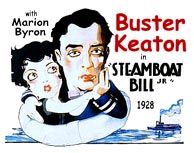

United Artists
Cast: Buster Keaton (William Canfield, Jr.), Ernest Torrence ("Steamboat Bill"), Marion Byron (Kitty King), Tom McGuire (J.J. King), Tom Lewis (Tom Carter)
William Canfield, best known as Steamboat Bill, is a crusty
old riverboat captain whose business is suddenly challenged by
the introduction of a new steamboat in River Junction, the King,
named after J.J. King, the richest man in town who owns about
everything else in the small community. Bill is delighted to find
out that his son is coming for a visit - a son he hasn't seen
since he was a baby. Arriving from college in Boston, Bill expects
a big, brawny young man much in the same physical make-up of himself.
He is more than disappointed when the diminutive William Canfield
Jr. arrives in striped jacket, bowtie, and beret, sporting a wisp
of a mustache and carrying a ukulele. Bill immediately takes him
to the barber to have the mustache removed, buys him a new hat
and crushes the ukulele under his foot. It turns out that J.J.
King's daughter, Kitty, knows Bill Jr., otherwise known as "Willie,"
from school. The two are attracted to one another, but both fathers
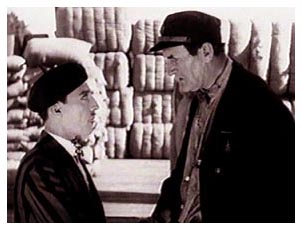 disapprove and try to keep them apart. As
a matter of fact, Bill is so put out with Willie's persistence
in associating with the Kings that he buys him a ticket back to
Boston. As Willie is walking to the train station dejectedly,
he sees his father being taken to jail after a fight with King.
Willie resolves to stay and get his father out of jail. He bakes
a loaf of bread with tools inside, but is caught, knocked out
by the sheriff, and taken to the hospital. While in the hospital,
a terrible cyclone comes up. The hospital is blown away, and the
jail, which was located on the banks of the river, has slipped
down into the river. Bill is locked in the cell as the jail slowly
sinks. It is up Willie to save his father, as well as rescue his
girl and her father.
disapprove and try to keep them apart. As
a matter of fact, Bill is so put out with Willie's persistence
in associating with the Kings that he buys him a ticket back to
Boston. As Willie is walking to the train station dejectedly,
he sees his father being taken to jail after a fight with King.
Willie resolves to stay and get his father out of jail. He bakes
a loaf of bread with tools inside, but is caught, knocked out
by the sheriff, and taken to the hospital. While in the hospital,
a terrible cyclone comes up. The hospital is blown away, and the
jail, which was located on the banks of the river, has slipped
down into the river. Bill is locked in the cell as the jail slowly
sinks. It is up Willie to save his father, as well as rescue his
girl and her father.
"Steamboat Bill, Jr." is a milestone in Buster Keaton's life because this was his last independently produced film. Having his own studio, established under the guidance of brother-in-law Joseph Schenck (married to Norma Talmadge while Buster was married to Natalie Talmadge) at United Artists, gave Keaton the freedom he needed to put his genius on film. However, both of his preceding pictures - "The General" (1926) and "College" (1927) - had lost money, and the third financial loss in a row brought this era of Keaton's career to an end.
In Keaton: The Man Who Wouldn't Lie Down (Charles Scribner's Son, 1979), author Tom Dardis said, "It proved to be the worst disaster at the box office of all of Buster's United Artists releases, earning a domestic gross of only $358,839. The negative cost alone had been $404,282, and the final loss on this film probably exceeded a quarter of a million dollars. But the losses on 'Steamboat Bill Jr.' were by no means the worst for United Artists, for the films made at this time by Gloria Swanson, D.W. Griffith and others lost considerably more." As a side note, there has also been some conjecture by historians on how much responsibility lay with United Artists and their distribution/promotion of Keaton's films.
Schenck arranged a contract with MGM for Keaton which he later called "the worst mistake" of his life. He soon learned that the creative independence he had experienced throughout his film career suddenly disappeared at the huge movie factory.
When watching the film today, though, it is difficult to imagine why it was not profitable. Reviews were mixed, but the film is an enjoyable one - not the best Keaton made, but Keaton didn't make a bad feature; they were all far above the average comedy of the day, and "Steamboat Bill Jr." is no exception.
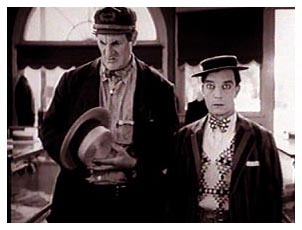 In The Theatre and Cinema of
Buster Keaton (Princeton University Press, 1999), author Robert
Knopf makes an astute observation. "During the first three
quarters of 'Steamboat Bill Jr.,' Keaton's gags serve to advance
the narrative as he moderates the gags' potential for disruption
by integrating them with the narrative and characterization, and
by keeping them on a physically and spatially small scale."
In other words, there is no broad slapstick here, although the
usual brand of Keaton physical comedy does appear. The gags, though,
are subtle and help advance the story line - and, yes, they are
funny. For example, the first view Steamboat Bill gets of his
son is when he sees him playing his ukulele and dancing and jumping
around in a very non-masculine manner. What Bill doesn't realize
is that Willie is simply trying to calm a crying baby that is
out of sight around the corner of the station. The humor here
is heightened because of an earlier exchange between Bill and
his first mate, Tom, when Bill received notice that his son, whom
he has not seen since he was a baby, is coming to visit. Tom comments,
"Must be a big lad now," to which Bill proudly replies,
"I'll bet he's bigger'n me!"
In The Theatre and Cinema of
Buster Keaton (Princeton University Press, 1999), author Robert
Knopf makes an astute observation. "During the first three
quarters of 'Steamboat Bill Jr.,' Keaton's gags serve to advance
the narrative as he moderates the gags' potential for disruption
by integrating them with the narrative and characterization, and
by keeping them on a physically and spatially small scale."
In other words, there is no broad slapstick here, although the
usual brand of Keaton physical comedy does appear. The gags, though,
are subtle and help advance the story line - and, yes, they are
funny. For example, the first view Steamboat Bill gets of his
son is when he sees him playing his ukulele and dancing and jumping
around in a very non-masculine manner. What Bill doesn't realize
is that Willie is simply trying to calm a crying baby that is
out of sight around the corner of the station. The humor here
is heightened because of an earlier exchange between Bill and
his first mate, Tom, when Bill received notice that his son, whom
he has not seen since he was a baby, is coming to visit. Tom comments,
"Must be a big lad now," to which Bill proudly replies,
"I'll bet he's bigger'n me!"
Although the love of two young people whose parents disapprove is as old as "Romeo and Juliet," the story is a good one with crusty old Steamboat Bill unable to compete financially with the rich J.J. King whose brand new riverboat, with crew in starched white uniforms, stands in direct contrast to Bill's old boat, the Stonewall Jackson. Even at the train station, we see a brand new bus with professionally painted wording on the side ready to transport passengers to King's new riverboat, while Bill's transport bus is an dilapidated open air contraption with an obviously hand-painted sign atop it. The story builds as we continue to see King apparently get the upper hand on Bill.
We also feel sympathy for Bill as he must endure the taunting and laughter of King. When King sees Willie for the first time in his foppish college attire, he mockingly asks, "Is that Steamboat Bill, Jr.?" Bill's anger is only intensified later when Willie's ukulele, which Bill stuffed into his back pocket at the train station falls out. King points and breaks into uncontrollable laughter. Bill starts to pick the instrument up, but changes his mind and stomps it into oblivion, stuffs his hands in his pockets and walks off furiously.
The conflict between the two men really comes to a climax when King succeeds in having Bill's boat condemned. Bill confronts King angrily, and the two end up grappling with one another. King has gained the upper hand once again as he now has Bill thrown in jail.
There are humorous moments resulting from the conflict between the two, though. Earlier, with the two boats almost touching bow to stern, Willie and Kitty try to speak to one another. However, King doesn't want Willie anywhere on his boat nor does he want Kitty on Bill's boat. When King orders one of his crew to remove Willie, the two end up grappling and falling onto Bill's boat. Bill orders Willie to "sock" the crew member, but, of course, Willie can't bring himself to do it. Bill takes Willie's hand, balls up his fist, and makes Willie hit the crewman, knocking him over the edge and into the water. Holding up Willie's fist, Bill says, "That's what that's for!"
Keaton could also add pathos into his films, maybe not as
heart-rending as Charlie Chaplin or Harold Lloyd, but sensitive
nonetheless. Bill has forbidden Willie to set foot on King's boat.
Even though Bill has taken his clothes so he can't go anywhere,
Willies finds some of Bill's old clothes in a closet and sneaks
out that night to see Kitty. When Bill looks out the window and
sees Willie climbing up the side of the King steamboat, he clutches
his fist and says, "Back to Boston you go." The next
morning, Willie is 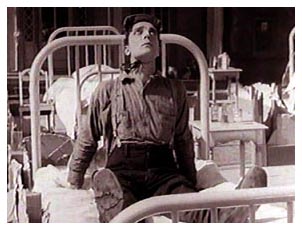 awakened by a pitcher
of water in the face as Bill hands him some money and a ticket
back to Boston and walks away. A very touching moment, but not
overly so for Keaton's character.
awakened by a pitcher
of water in the face as Bill hands him some money and a ticket
back to Boston and walks away. A very touching moment, but not
overly so for Keaton's character.
Of course, the rousing cyclone sequence at the end of the film gets most of the recognition, and even those who may not care much for the rest of the film find this rousing climax a delight. There is a combination of great gags and amazing effects. For example, we see patients rushing out of the hospital, and suddenly the entire building is lifted into the air and out of the frame. All we see now is a floor full of empty hospital beds - except one which has a disoriented Willie sitting straight up with an icepack on his head (the sheriff had knocked him out earlier when he tried to help his father escape from jail). At one point he is running around aimlessly in a field, and an entire building suddenly falls on top of him. Then we see Buster walking out of the door of the building. The most famous scene possibly in Keaton's entire cinematic output occurs when he is standing in the street in front of a building. The front of the building is coming loose, and we fear he is about to be crushed. And, yes, the winds finally do bring the entire façade down - but, amazingly, Willie is still standing. He was standing in just the exact spot for an open second story window to fall around him, leaving him unharmed. Much has been written about the danger this entailed - the wall had to be heavy so as not to buckle in the wind, and there were only two inches of clearance around Buster's head and shoulders - but he insisted on doing the stunt. Keaton later said that he probably would not have done the stunt if there had not been so many personal problems in his life at that time - so much so that he literally had an "I don't care" attitude about what happened to him.
Another amazing stunt takes place when Willie grabs on to a tree in the strong wind, but the entire tree is uprooted, and he flies through the air hanging on for dear life until he and the tree are dumped in the river. The stunt was achieved by a crane that was attached to the top of the tree and carried it across to the river.
This climax is not all gags, though. The viewer's attention
is also held by the fact that the jail has slipped down the riverbank
into the water. Bill is still in his cell, 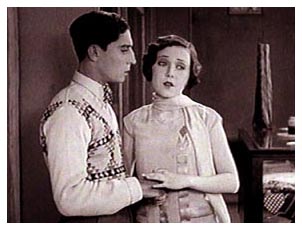 unable
to get out, and the water is quickly rising. In the same manner
as a D.W. Griffith race to the rescue, we see cross-cutting from
Willie taking control of the Stonewall Jackson to Bill inside
the cell with water rising to his waist, then his chest, and eventually
up to his chin as he struggles to keep his head above water. Willie
is shown in the engine room attaching a series of ropes to the
controls, and we wonder how he is going to rescue his father.
Willie then jumps into the wheelhouse with the ropes, pulls one,
then another, and the board lurches forward. Then we get a shot
of the bow of the boat charging forward at the jail - which only
has its roof now above the water line. The boat crashes into the
jail demolishing it into a mass of wooden rubble. Where is Bill?
This would seem impossible to survive - yet, suddenly, a head
pops up among the rubble - and Willie brings his father aboard.
unable
to get out, and the water is quickly rising. In the same manner
as a D.W. Griffith race to the rescue, we see cross-cutting from
Willie taking control of the Stonewall Jackson to Bill inside
the cell with water rising to his waist, then his chest, and eventually
up to his chin as he struggles to keep his head above water. Willie
is shown in the engine room attaching a series of ropes to the
controls, and we wonder how he is going to rescue his father.
Willie then jumps into the wheelhouse with the ropes, pulls one,
then another, and the board lurches forward. Then we get a shot
of the bow of the boat charging forward at the jail - which only
has its roof now above the water line. The boat crashes into the
jail demolishing it into a mass of wooden rubble. Where is Bill?
This would seem impossible to survive - yet, suddenly, a head
pops up among the rubble - and Willie brings his father aboard.
Next he must rescue Kitty, who is on a house that is floating on its side down the river. The real coup de grace comes next when we see King floundering in the water next to his sunken steamboat. His boat did not withstand the storm, while Bill's Stonewall Jackson was there to save the day. Of course, all ends well with the two men shaking hands and Willie towing a minister in from the water for the inevitable marriage.
"Steamboat Bill, Jr." evolved from an idea brought to Keaton by Charles (Chuck) Reisner who was also loaned out from Warner Brothers to direct the film. It was filmed almost entirely on the banks of the Sacramento River across from the state capital. A three-block long town front was constructed in the summer of 1927 for the set.
Keaton had originally planned a flood as the film's climax instead of a cyclone, but, as he explained in his autobiography, My Wonderful World of Slapstick (DeCapo, 1982), "One of Joe Schenk's aides talked him into the idea that a flood would be a ruinous thing to have in a movie comedy. 'You'll make a lot of enemies for this picture if you keep the flood in it,' he told Joe. 'Too many people have lost their dear ones in recent floods. They will resent us making a joke out of such a disaster.' When Schenck told me this, I pointed out that one of Chaplin's greatest successes was 'Shoulder Arms,' a picture making fun of the war and everything connected with it. 'Chaplin made that movie in 1919, the year after the World War ended,' I said. 'Nobody objected to it. And that includes the gold-star mothers who lost their sons in the war.'"
Keaton lost the argument on this one, although there are some flood elements in the cyclone sequence. In Buster Keaton: Tempest in a Flat Hat (Newmarket Press, 2004), author by Edward McPherson pointed out, "And so (Fred) Gabourie (technical director) rebuilt the sets while Buster rerouted the comedy. The adjustment cost almost $35,000, which raised the question: Who was the true wastrel, Buster or the beancounter?"
"It had occurred to me that there were usually many
more people killed each year by cyclones and tornadoes than floods,"
Keaton said in his autobiography. "Just for fun, when the
picture was over, I called the United States Weather Bureau in
Los Angeles and asked for figures for the preceding year. I was
told that in 1925 there were 796 persons killed in great windstorms
and only 36 in floods. But I never mentioned that to Schenck,
not wishing to rub it in. I usually could make Joe laugh, 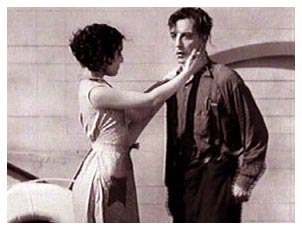 but I doubted that he would be amused to hear
about the $35,000 mistake he had made."
but I doubted that he would be amused to hear
about the $35,000 mistake he had made."
Historian and film producer Kevin Brownlow (The Parade's Gone By, Bonanza Books, 1968) apparently wasn't impressed with "Steamboat Bill, Jr.," but he was impressed with the cyclone sequence. "As a whole, it does not have the sustained quality of the usual Keaton product, but the last part of the film is unforgettable. It eclipses for sheer panache anything he ever did."
Jim Kline, in The Complete Films of Buster Keaton (Citadel Press, 1993), said, "Despite its initially disastrous draw, 'Steamboat Bill, Jr.' is easily one of Buster's best and most spectacularly inventive films. It also contains some of his most ingeniously subtle yet intricately times pantomime segments. . . Buster and Marion Byron act out a series of near-miss encounters in the middle of town with the two actors conveying an amazing range of emotions with simple facial glances and expressive body language. Beautifully filmed, wonderfully acted by all, and containing the most exciting climax of any of his films, 'Steamboat Bill, Jr.' comes close to matching the all-around perfection Buster achieved with his masterpiece, 'The General'."
The New York Times (May 15, 1928) flatly panned the film. "Buster Keaton's latest attempt to make the millions laugh is a sorry affair. It is known as 'Steamboat Bill Jr.,' and the producer appears to rely chiefly on water and smashing scenery to create fun. It seems longer than it really is, and the end strikes one as being brought about through sheer failure. . . Ernest Torrence succeeds in demonstrating his talent in spite of the lethargy of this film. Mr. Keaton preserves his stoicism, but while watching this film one feels that one looked rather like Mr. Keaton ths greater part of the time, which is probably not exactly what Mr. Keaton was aiming at."
Such a review is not surprising for the usually hard to
please Times reviewer, and it stands outs in stark contrast
to the way Variety's (May 16, 1925) reviewer saw the film.
"Whatever may have been the real reason why United Artists
took its time about releasing this one, it had nothing t do with
quality, for it's a pip of a comedy. Lovers of comedy and picture
house regulars will like this latest Keaton film. It's one of
his best. . . An excellent cast gave Keaton and Torrence big league
support. 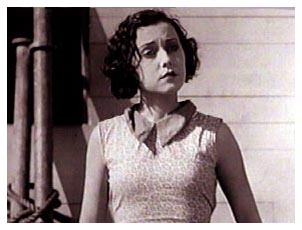 The late Tom Lewis as the first
mate, Mr. McGuire as the rival owner, and Marion Byron as the
girl, contributed heavily. . . The picture looks like a heavy
production outlay and warrants it, for the effects obtained are
thrilling. The windstorm is a gem and the river stuff interesting
and colorful. . . Keaton does some back-breaking acrobatics in
his awkward attempts to master seamanship, some of the falls looking
dangerous. The gags maintain an even tempo of laughs and are all
new to picture house audiences, although several are reminiscent
to a vaudevillian."
The late Tom Lewis as the first
mate, Mr. McGuire as the rival owner, and Marion Byron as the
girl, contributed heavily. . . The picture looks like a heavy
production outlay and warrants it, for the effects obtained are
thrilling. The windstorm is a gem and the river stuff interesting
and colorful. . . Keaton does some back-breaking acrobatics in
his awkward attempts to master seamanship, some of the falls looking
dangerous. The gags maintain an even tempo of laughs and are all
new to picture house audiences, although several are reminiscent
to a vaudevillian."
Harrison's Reports (May 26, 1928) also praised the film, although not as exuberantly as Variety. "The plot is nonsensical, but the spectators at the Rialto Theatre, where it is now shown, went into hysterics laughing. . . There are many situations all the way through that cause laughs, these being the result of Mr. Keaton's acting. The scenes of the cyclone are the best part of he film; they cause the most thrills." However, the reviewer may, in his caution to exhibitors, have given at least some insight into why the film did not do well at the box office. "The satisfaction this picture will give will, no doubt, depend on whether the theatre is full or empty when it is shown. If it is full, they will like it well; if it is empty, they may go away dissatisfied. But in making up your mind as to what you should pay for it, don't fail to take into consideration the performance of Keaton's last two or three pictures; they are bound to affect the drawing powers of this one. In other words, if his past two or three pictures drew well, this one, too, may draw well, in proportion to the business conditions that prevail now as compared to the business conditions that prevailed when you showed the others; if the others failed, it is doubtful if 'Steamboat Bill, Jr.' will fare better, particularly because business conditions are poor now."
"Steamboat Bill, Jr." is excellent entertainment with many elements of a good picture that succeed - great gags, albeit a little more subdued than much of Keaton's output; a good story line with both love interest and sufficient conflict to arouse our emotions; a rousing climax of epic proportions; and a race-to-the-finish rescue that makes the viewer grip the edge of his seat. Kino's release has a wonderful organ score by the late Gaylord Carter that works so well, and the picture quality is superb. It's a must-see for anyone who has never seen the film before, and, for those who have, it is one of those that you don't mind pulling off the shelf once in awhile, dusting off, and enjoying all over again.
Copyright 2006 by Tim Lussier. All rights reserved.